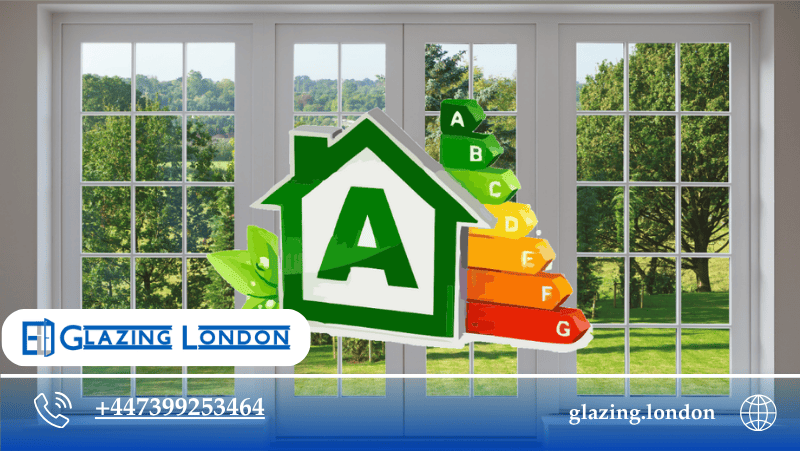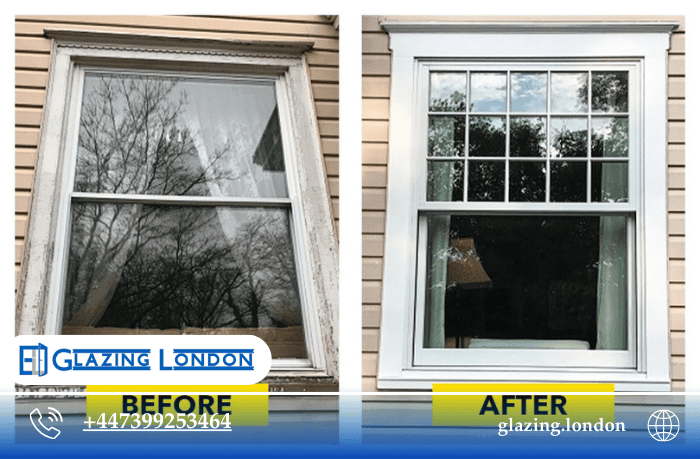Discover how this simple , affordable solution can save energy , reduce noise , and make your London home more sustainable .
Introduction: London’s Hidden Energy Problem
London’s skyline might be filled with glass and steel , but behind those charming Victorian facades and Georgian townhouses lies a problem: poor insulation .
Thousands of homes across the capital lose up to 25% of their heat through old , single-glazed windows .
The solution most homeowners think of first? Double glazing .
But what if you could get the same — or even better — results without replacing your existing windows?
Welcome to the world of secondary glazing — London’s most overlooked eco-friendly upgrade .
Secondary glazing is a discreet , energy-saving system that adds an additional pane of glass to your existing window frame . It’s cost-effective , preserves your home’s character , and helps you save money on heating bills while reducing carbon emissions .
And yet , it remains one of the least understood sustainability improvements in the city .
Glazing London
What Is Secondary Glazing (and How Does It Work)?
Secondary glazing involves installing an additional glass panel inside your existing window . It creates an insulating air gap between the two layers of glass , dramatically improving energy efficiency , soundproofing , and security .
Unlike double glazing , it doesn’t require you to remove or replace your current windows . That makes it ideal for heritage buildings , listed properties , and period homes where replacing original sash or casement windows isn’t an option .
How It Works in Simple Terms:
- The secondary pane traps a layer of air (or gas) between itself and the primary window .
- This air acts as insulation , reducing heat transfer .
- As a result , you retain more warmth in winter and keep cool in summer .
It’s like adding a thermal shield to your home — invisible , efficient , and budget-friendly .
Door Installation in London
Why London Homeowners Overlook Secondary Glazing
Despite its benefits , secondary glazing often flies under the radar . Here’s why:
- Lack of Awareness: Most people only know about double glazing because it’s heavily advertised .
- Historic Homeowners’ Fear: Many think secondary glazing will ruin the look of their heritage windows — which is false . Modern systems are nearly invisible .
- Confusion About Performance: Some assume it doesn’t insulate as well as double glazing , but high-quality systems can rival — or exceed — standard double glazing .
- Assumption About Cost: Many expect it to be expensive , while it’s actually one of the most affordable eco-upgrades in London homes .
These misconceptions mean thousands of Londoners miss out on an upgrade that could reduce their heating bills by up to 60% .

Double Glazing Door Installation in London
The Eco-Friendly Impact of Secondary Glazing
Let’s talk about what matters most — the environment .
1 . Energy Efficiency
Adding secondary glazing to single-glazed windows can reduce heat loss by up to 65% , cutting both carbon emissions and energy bills .
For the average London flat , that’s a saving of £150–£300 a year on heating costs .
2 . Reduced Carbon Footprint
Every degree of heat you keep inside your home means less fuel burned by your boiler . For an average household , this can translate to up to 500kg less CO₂ emitted per year .
3 . Sustainable Materials
Most secondary glazing systems use recyclable aluminium frames and low-emission glass . They’re built to last 20–30 years with minimal maintenance .
4 . No Wasteful Replacement
Unlike window replacement , secondary glazing doesn’t generate construction waste or landfill debris . You keep your original frames — meaning zero materials end up wasted .
5 . Compatibility with Solar Gains
Secondary glazing allows natural light to pass through efficiently , helping you benefit from passive solar heat in winter .
Secondary glazing doesn’t just help the planet — it helps your wallet too .
Window installation in London
Secondary Glazing vs Double Glazing: The Smart Comparison
| Feature | Secondary Glazing | Double Glazing |
| Installation | Fitted inside existing frame | Replaces existing window |
| Ideal For | Period homes , listed buildings | Modern properties |
| Heat Retention | Excellent (up to 65%) | Excellent (up to 70%) |
| Cost | 30–40% cheaper | More expensive |
| Noise Reduction | Up to 80% less noise | Moderate reduction |
| Eco Impact | Keeps original materials | Generates waste |
| Planning Permission | Rarely required | Often needed for listed homes |
Verdict:
For Londoners living in heritage homes or flats where replacements are complicated , secondary glazing delivers nearly the same benefits — without the cost or hassle .

Why Secondary Glazing Fits Perfectly in London Homes
London’s housing stock is unique . From Kensington terraces to Hackney warehouse conversions , no two windows are the same .
Secondary glazing adapts to these differences beautifully .
Here’s why it’s particularly suited to London life:
Double Glazing Window Installation in London
✅ Heritage Friendly
Most London boroughs (especially Islington , Camden , and Westminster) have strict regulations on altering original windows . Secondary glazing keeps your exterior untouched .
✅ Compact Living
For smaller flats and maisonettes , the installation is quick and doesn’t require scaffolding or major works .
✅ Weather-Resistant
London’s damp winters and draughty old frames make secondary glazing an instant comfort upgrade .
✅ Cost-Effective for Renters & Landlords
It’s an affordable retrofit that improves EPC ratings — a growing priority for landlords under new energy regulations .
Beyond Energy: Hidden Benefits Homeowners Love
- Soundproofing: Living near busy roads or train lines? Secondary glazing cuts outside noise by up to 45 dB — that’s like closing the door on city chaos .
- Condensation Control: The air gap reduces internal condensation , protecting wooden frames from rot and mould .
- Improved Security: The extra layer of glass and lockable frames deter break-ins .
- Comfort Boost: Rooms stay warmer , quieter , and cozier — without altering the look of your windows .
Real-Life Case Study: A London Flat That Went Green
In Islington , a homeowner in a Grade II listed flat was losing heat through original sash windows . Double glazing wasn’t allowed under local conservation rules .
Our team installed discreet magnetically sealed secondary glazing .
Results within 2 weeks:
- Heating bills dropped by 25% .
- Room temperature stayed stable even during snow .
- Street noise reduced dramatically .
- The building’s character remained untouched .
The homeowner called it “the most effective home improvement I’ve ever made .”
The Marketing Message: Small Change , Big Difference
This is where content marketing meets sustainability education .
Most Londoners think energy upgrades mean expensive renovations . Through strategic blog posts , SEO content , and storytelling (like this one) , brands like Glazing London can reshape perception .
By publishing guides , visuals , and real stories about secondary glazing benefits , you:
- Educate potential customers who didn’t know this was an option .
- Build trust by showing transparency in cost and performance .
- Convert readers into customers through value-first marketing .
💡 Modern SEO isn’t about selling products — it’s about solving problems before the customer even realises they have one .
That’s exactly what articles like this do .
The Buying Journey: From Awareness to Action
- Stage 1 (Awareness):
User searches “how to reduce energy bills London .”
→ Finds this article . Learns secondary glazing exists . - Stage 2 (Consideration):
User reads comparisons between secondary and double glazing .
→ Realises it’s cheaper , eco-friendly , and practical . - Stage 3 (Decision):
User clicks your CTA: “Book a free quote” or “Schedule a property assessment .”
That’s content marketing in action — educating → building trust → converting .
How Much Does Secondary Glazing Cost in London?
While prices vary by window size and design , here’s a general guide:
| Type | Average Cost (per window) | Energy Saving Potential |
| Small Casement | £250–£350 | 20–30% heat reduction |
| Large Sash Window | £350–£500 | 35–50% heat reduction |
| Bay/Bow Window | £600–£900 | 45–60% heat reduction |
Considering that heating costs in London average £1 ,200–£2 ,000 per year , this upgrade typically pays for itself in 2–4 years .
Maintenance & Longevity
One of the biggest advantages of secondary glazing is its low maintenance .
- Clean the interior pane like any normal glass .
- No re-sealing or repainting needed .
- Magnetic or hinged designs make access easy .
- Most systems last 20–30 years with zero replacement parts .
It’s an investment in comfort , not a recurring cost .

Eco-Friendly Future of London Homes
The UK government’s Net Zero 2050 plan encourages homeowners to improve energy efficiency — and glazing plays a big part .
While large corporations push double glazing , secondary glazing quietly supports heritage , affordability , and sustainability .
By promoting this upgrade through smart content marketing , brands can position themselves as:
- Eco-conscious
- Cost-transparent
- Customer-first .
Glass Replacement in London
Ready to Go Green?
If your home feels cold , noisy , or drafty — you don’t need a full renovation .
You just need smart glazing .
Our secondary glazing experts in London provide:
- Free property assessments
- Tailored eco-upgrade plans
- Fast installation
- Competitive pricing
📞 Contact Glazing London today and see how easy going green can be — one window at a time .





